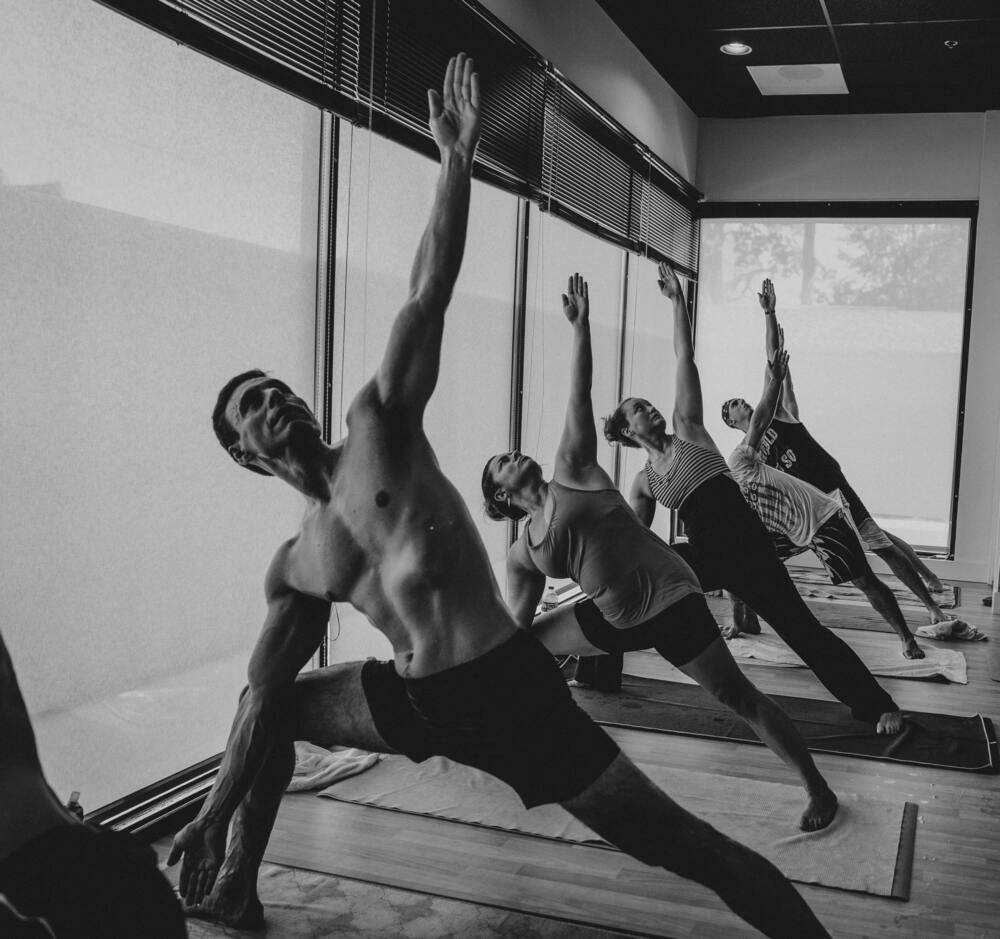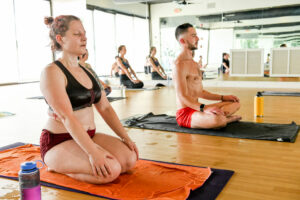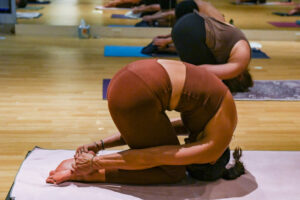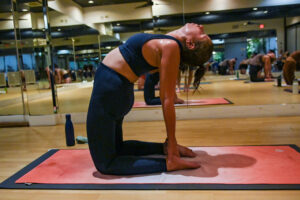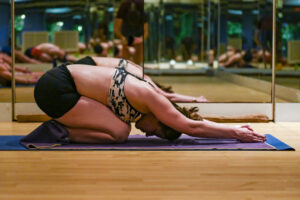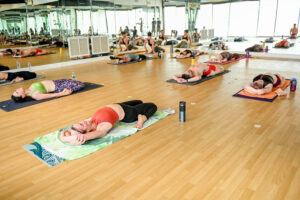Fly like an eagle, or at least stand like one!
Whether you think Steve Miller Band or Seal sang it better, one thing is for sure, they weren’t talking about Bikram Yoga! The eagle pose, also known as Garudasana, is quite still, unlike the soar of our national bird. As a result, this pose takes a great deal of concentration and focus, and most of all, balance!
In the ancient Indo-European language of Sanskrit, Garuda translates to the mythic “king of birds” which represents strength, power, and freedom. So, it is no surprise that this particular pose takes a great deal of centering and coordination.
More like a twisted pretzel, this standing pose challenges the body’s ability to steady itself and distribute weight evenly. Consequently, garudasana, when practiced regularly, has many benefits including increased flexibility and strength.
Before we talk about getting started, here’s what’s covered in this article:
Step-by-Step Eagle Pose Instructions
The Benefits
Modifications
Eagle Pose FAQs
So, how do you get started?
Performing the pose: Step by step instructions
1: Begin in a standing position with your feet together and your arms at your sides.
2: Bend your knees slightly, lift your right foot, and cross your right thigh over your left thigh.
3: Point your toes towards the floor and balance on your left foot.
4: Bend your elbows and bring your forearms in front of your face.
5: Cross your left arm over your right arm and interweave your forearms so that your palms touch.
6: Lift your elbows and fingertips towards the ceiling and gaze towards your fingertips.
7: Hold the pose for 20-60 seconds, then release your arms and legs and return to standing.
8: Finally, repeat the pose on the other side by crossing your left thigh over your right thigh and bringing your right arm over your left arm.
Discovering the Benefits
Unfortunately, we have become a nation of slouchers. Whether it is long days slumped over a desk or walking in improper footwear, more and more Americans are showing poor posture. One way to improve your stance is to stretch and strengthen the muscles in your shoulders, neck, arms, back and core. The eagle pose spreads your scapula, stretching your shoulders and upper back muscles. This can help improve posture and release muscle tension.
Here are some other benefits to practicing garudasana:
- Improves flexibility: By standing cross-legged you invoke a deep stretch in the hips and thighs, which can improve flexibility and relieve tightness.
- Improves digestion: The twisting motion within the abdomen helps to stimulate the digestive system, which helps move food and liquid through the GI tract.
- Relieves stress and anxiety: With the level of concentration necessary to maintain balance, this pose can calm the mind and reduce stress and anxiety.
- Improves circulation: By compressing and releasing the veins and arteries in the legs and arms, this pose can increase circulation to those parts of the body.
- Strengthens the legs and ankles: Balancing in the eagle pose requires strength in the legs and ankles, which will improve overtime with practice.
- Alleviates back pain: While stretching and building strength, this pose can be therapeutic for those with sciatica and lower back pain.
- Aids in breathing: By opening up the back lungs, the eagle pose increases breathing capacity helping to achieve a full inhale and exhale.
- Protects the knees: The stretching and strengthening of your knees during this pose can help prevent against future injury.
Modifications for Comfort and Safety
Garudasana can surely be a challenge. It takes time and practice to really master this pose, and can be difficult even for experienced yogis. Here are some modifications that may make your experience more comfortable:
- If wrapping your arms is uncomfortable, you can cross your arms and place your hands on opposite shoulders. A strap can also be used if you have limited shoulder mobility, by holding it taut in both hands out in front of you, instead of crossing your arms.
- If balancing is an issue, place a block next to your standing foot and rest the toes of your wrapped leg on top, instead of hooking your foot behind your calf. If you do not have a block handy, you can try to rest the big toe of your wrapped leg on the floor.
- If crossing your legs is too challenging all together, consider crossing your ankles instead.
- If you are still working on your balance, you can put your back up against a wall for added support.
Step-by-step modifications
If the overall pose is too difficult at first, you can start in a sitting position rather than standing. Here is how you would practice the eagle pose while sitting:
1: Sit on your mat with your legs extended in front of you.
2: Bend your knees and bring your feet flat on the floor.
3: Cross your right thigh over your left thigh, and wrap your right foot around your left calf.
4: Bend your elbows and bring your arms out in front of you.
5: Cross your right arm over your left arm, and bring your palms together.
6: Lift your elbows up and move your forearms away from your face.
7: Hold the pose for 30 seconds to 1 minute, then release and repeat on the other side.
Soar to New Heights with Garudasana & Take a Class Today!
Although challenging, the numerous benefits of the eagle pose outweigh its complexity, including improved balance, circulation, and stress relief. Plus, you’ll look pretty cool doing it!
Modifications may be necessary for beginners or those with limited mobility. By practicing the eagle pose regularly and with patience, you can reap its many benefits and develop a deeper connection with the body, mind, and breath. Who doesn’t want that?
Whether you practice yoga regularly or you have been interested in taking a class for a while now, the only way to perfect your pose is through instruction and practice. Our Bikram yoga classes take place several times a week and cycle through all 26 hot yoga postures.
Consider Signing up today and come practice your eagle pose with us at YogaSol!
FAQs about Eagle Pose
I’m worried about injuring myself while attempting the pose. Will I be ok?
Your YogaSol instructor will be happy to help you prepare properly and make any necessary modifications to the pose. You are also welcome to stop anytime that you feel uncomfortable without judgment. We want this to be a safe and fun experience for everyone.
What if I am not able to focus and lose my balance?
Even the greatest yogis lose their balance from time to time. There is no need to be embarrassed, it is just part of the learning process. As you practice, you will see your balance improve with time.
Will I be able to stay hydrated enough in class?
We recommend that you keep water with you at all times during your session. Hydrating is important for all exercise practices, especially hot yoga. Our instructors make sure to encourage hydrating throughout class. We also advocate for hydration before and after class.
 -ing our NEW! Community Classes!
-ing our NEW! Community Classes!
